Unusual-looking and pleasant-tasting watermelon radish: what is good and how to grow
Watermelon radish (radish) is a hybrid culture, named for the similarity of the pulp to the melon berry. Its color ranges from pink to purple. The root vegetable taste combines a piquant bitterness and pleasant sweetness. An interesting appearance, early maturity and the possibility of widespread cultivation make the culture popular with gardeners.
In this article, we will talk about the technology of growing watermelon radish, its beneficial properties, advantages and disadvantages.
The content of the article
Hybrid characteristics
Watermelon radish, or rather radish, is a hybrid belonging to the cruciferous family... The culture was bred by European breeders, and quite quickly it gained recognition throughout the world. Depending on the place of growth, they are distinguished: European, Japanese and Chinese varieties of watermelon radish.
In Russia, culture appeared in the early 2000s, and in the EU and the USA, the root vegetable is part of restaurant dishes.
Reference. The culture was grown under the conditions of the International Space Station in order to identify genetic characteristics.
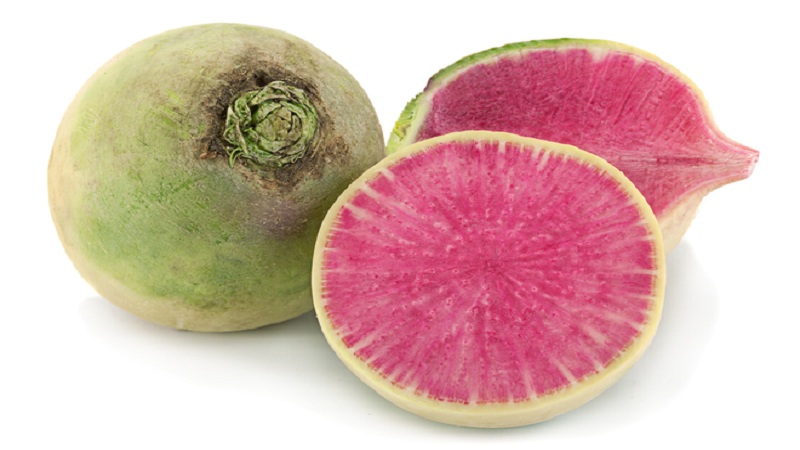
Description of fruits, yield
Root crops come in different shapes: oblong, fusiform, round. The color of the flesh varies from faint pink to deep purple. The skin is white-green.
The diameter of a round root crop, the most popular in our country, is 8-9 cm.
The structure of the pulp is denser and drier compared to regular radish... The skin has a bitter taste, and the middle is sweet and pleasant to the taste. The intensity of the bitterness depends on the amount of mustard oil. The severity of taste gradually smoothes out as the root crop matures, but the ratio of the sugar middle and the bitter skin remains.
Watermelon radish - high-yielding crop, characterized by cold resistance, withstands short-term frosts down to -5 ° С... Subject to the rules of agricultural technology, several tens of tons of root crops are harvested from 1 hectare of land. The productivity of a crop depends on the size of the seed, the larger the seeds, the higher the yield.
It is interesting:
What vitamins are in radishes and how is it useful
The benefits and harms of radishes for the body
Review of the best varieties of radish for open ground and greenhouses
Benefit and harm
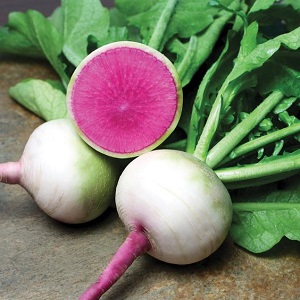 Watermelon radish contains:
Watermelon radish contains:
- vitamins A, C, group B;
- minerals: potassium, calcium, sodium, phosphorus, iron, magnesium;
- nicotinic, salicylic and folic acid;
- glycosides;
- mustard oil.
Its rich chemical composition makes the product incredibly healthy. Frequent use of root vegetables:
- increases the body's defenses;
- reduces fatigue;
- increases efficiency;
- normalizes the digestive tract and increases appetite;
- strengthens hair follicles;
- increases skin turgor;
- improves blood supply to the brain.
Nutritional value per 100 g:
- calorie content - 35 kcal;
- proteins - 2.5 g;
- fats - 0.3 g;
- carbohydrates - 2.9 g
Low in calories and high in digestible protein allows you to include radishes in your weight loss menu.
Important! The use of the product is undesirable for stomach ulcers in the acute stage, gastritis with high acidity due to irritating effects on the gastric mucosa.

Agricultural technology of watermelon radish
The culture is included in the sowing radish group, therefore, the technology for growing these root crops is practically the same. A short growing season (about a month) allows you to get 4-5 harvests per season.
The best results are achieved when sowing in July... Comfortable weather conditions for the culture: average daily air temperature + 20-25 ° С, minimum precipitation.
Landing
Watermelon radish grows best on sandy loam and loamy soils with neutral pH (equal to 7). Acidic soil (with a pH of more than 7) is "deoxidized" with dolomite flour, chalk, lime, and alkaline (with a pH of less than 7) is treated with peat.
Hard and mineral-poor soil is not suitable for growing crops, as well as "overfed" organics. Radish loves loose and fertile soil. Therefore, before sowing, the plot is dug up to the depth of a bayonet shovel in autumn and fertilized with manure (4-5 kg per sq. M), superphosphate (13-20 g per sq. M), potassium chloride (16-20 g per sq. M). In the spring, the soil is loosened and ammonium nitrate (12-18 g per sq. M) is added. The plot is mulched with peat, hay, straw.
Reference. The best precursors for watermelon radish are cucumbers, tomatoes, potatoes, beans, and peas.
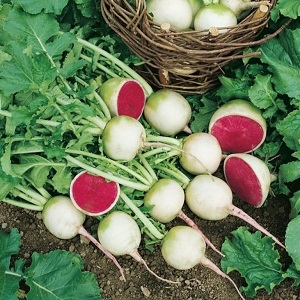 Sowing seeds is carried out directly into the ground, heated to + 8 ° С... The term depends on the region of growth. In the southern regions, sowing work begins in late April - early May, in the middle lane - two weeks later.
Sowing seeds is carried out directly into the ground, heated to + 8 ° С... The term depends on the region of growth. In the southern regions, sowing work begins in late April - early May, in the middle lane - two weeks later.
The material is soaked for 24 hours in cold water for swelling, acceleration of germination and the formation of even root crops.
Wells are formed with a depth of 3-4 cm... A pinch of superphosphate is poured into each and sprinkled with a small layer of earth. The seeds are sealed to a depth of 2 cm, covered with soil, easily compacted and watered with warm, settled water. The distance between plantings is 40-50 cm - the radish loves space. The first shoots appear in 2-3 days.
Care
The main condition for the successful cultivation of watermelon radish is compliance with watering rules... Lack of moisture leads to shooting of the ground part, slow formation and woodiness of root crops, the appearance of internal voids, a deterioration in taste, and a decrease in useful properties.
An excess of moisture provokes decay and the addition of fungal and bacterial infections. Regular to moderate watering once a week is the best solution. Sprinkler irrigation is carried out in hot weather.
Loosening of the soil and weeding is carried out once every 3-4 days... This allows you to saturate the horse system with oxygen, accelerate the formation of root crops.
Watermelon radish - early ripening culture, does not like an overabundance of minerals and organics, therefore, potassium-phosphorus fertilization is applied once before sowing.
Diseases and pests
Failure to comply with the rules of agricultural technology leads to infection with viruses and bacteria.
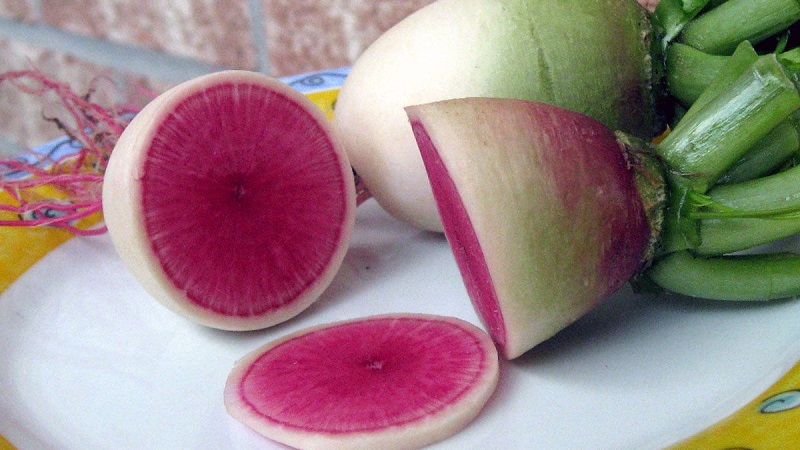
Against the background of increased acidity of the soil, a fungal disease occurs - keela... In an unfavorable environment, fungal spores develop rapidly, which are carried by worms. Root vegetables become deformed, covered with growths and become too tough. There is no cure for the disease. For prophylaxis, before sowing, the soil is deoxidized with lime, chalk or dolomite flour, treated with copper sulfate (50 g per sq. M).
Excess moisture in the soil, untimely weeding of weeds, non-compliance with crop rotation provokes the development of powdery mildew, gray rot and white rust.
Powdery mildew manifests itself as a white bloom on the leaves and petioles. Later, the plaque turns brown, the leaves dry and deform.
Gray rot recognized by brown spots on leaves with a gray fluffy bloom.
White rust - one of the most common diseases of the cruciferous family. Stems and leaves are covered with an oily white coating. Without treatment, plant tissues become brown and dry.
For the treatment of fungal infections, use copper sulfate, Bordeaux liquid, "Ridomil Gold MC", "Skor", "Oxyhom", "Hom", "Fundazol", "Ditan M". To prevent the fungus from developing resistance, preparations are alternated from season to season. For better adhesion of the products to the green mass, 50 g of shavings of laundry soap are added to the solution.
Spring planting affects cabbage fly and cruciferous flea... Insects feed on green matter, which causes the plant to dry out.
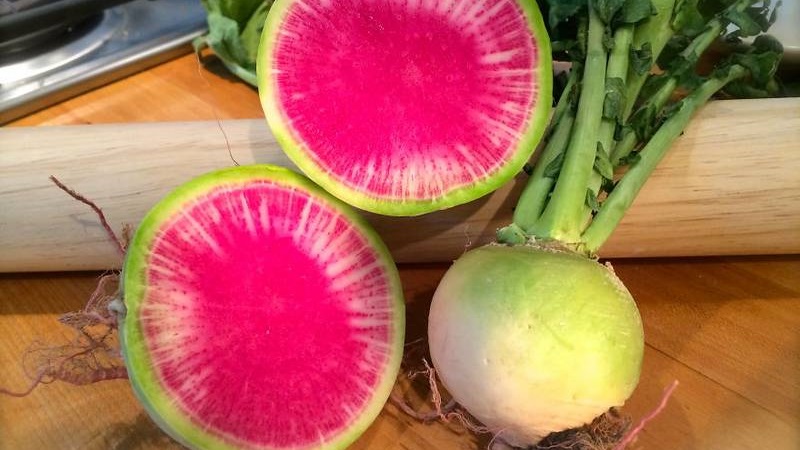
To combat the pest, such means are used:
- mix tobacco shag, ash, naphthalene, camphor in equal parts and pollinate closer to the petioles twice with an interval of a week;
- prepare a solution of ammonia (5 ml per 10 liters of water) and water the plantings;
- saline (200 g per 10 l of water) water the plants under the bush;
- prepare an infusion of bay leaves (10 g per 1 liter of boiling water) and spray the radish;
- dust the planting with a mixture of ash and road dust;
- take 200 g of garlic arrows and tomato tops, chop in a meat grinder, pour 10 liters of warm water and add 20 ml of liquid soap;
- spray the plantings with a vinegar solution (200 ml of 9% vinegar per 10 liters of water);
- in the evening, treat the plants with insecticides "Sherpa", "Decis", "Aktara", "Arrivo".
To prevent infection, the planting is covered spunbond, agrospan or lutrasil, observe the rules of agricultural technology.
Harvesting and application of the crop
Collecting root crops is carried out as they ripen, morning or evening in dry weather and finish before the onset of frost.
The collected radish is left to dry in the garden bed. A cool room is used for storage. The fruits are inspected for damage, the tops are cut, leaving 2 cm, put in a box and sprinkled with ash or chalk.
Shelf life is 2-3 months at temperatures from 0 to + 6 ° C.
Not only root crops are used for food, but also tops... The green part is added to salads, soups, cold cakes, okroshka.
The fruits are baked, stewed, boiled, added to vitamin salads, snacks... Radish goes well with meat, fish, vegetables. It is recommended to cut the peel before cooking. The pulp is cut into thin slices and sprinkled with salt, garnished with sandwiches and soft drinks.
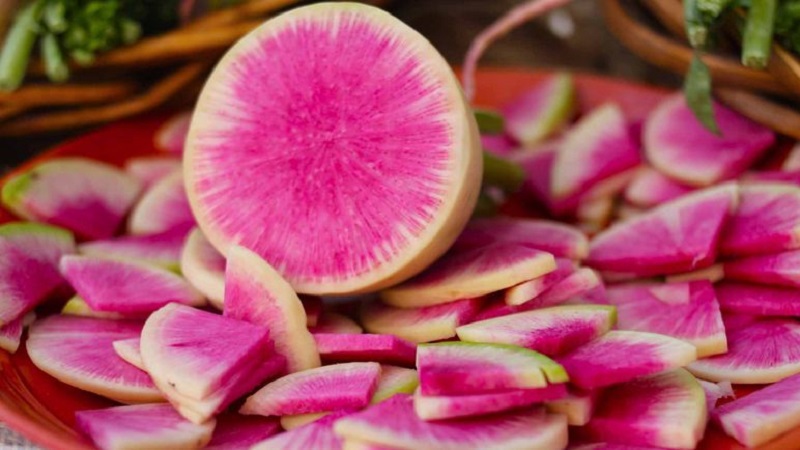
Watermelon radish salad with cucumbers and carrots
Ingredients:
- 300 g watermelon radish;
- 300 g cucumbers;
- 200 g carrots;
- a bunch of dill;
- 150 g sour cream 15%;
- juice of half a lemon;
- 1 tsp liquid honey;
- 0.5 tsp French mustard;
- sea salt, black pepper to taste.
Preparation:
- Wash, peel and chop the vegetables into thin strips with a sharp knife, or use a Chinese carrot grater.
- Rinse the dill under running water, dry and chop finely.
- Prepare a salad dressing: Combine sour cream, mustard, honey, lemon juice, salt and pepper in a bowl. Whisk the sauce until smooth.
- Place the vegetables in a bowl, add the dill, pour over the dressing and stir.
Take a note:
Simple and delicious recipes for healthy snacks for the winter
Top 8 best pickled radish recipes
Harvesting radish for the winter by freezing and in other ways
Features of growing indoors and outdoors
In the regions of the middle lane sowing begins in the third decade of March in greenhouses or greenhouses. The first crop is harvested in April.
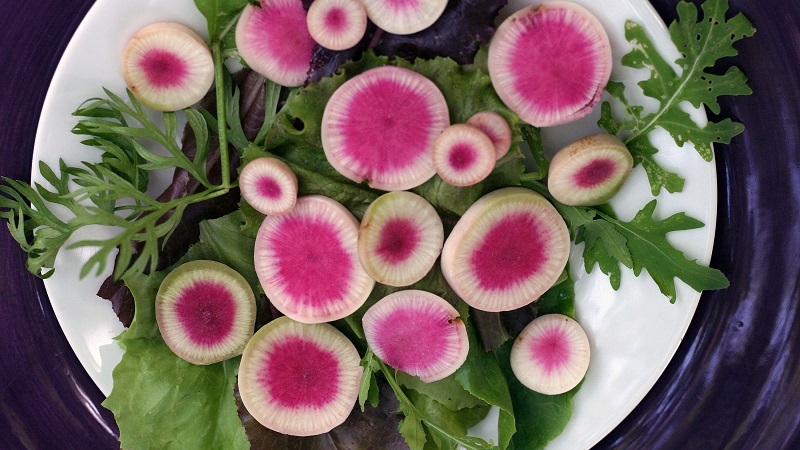
In unprotected soil, seeds are sown in May and a month later they get a harvest. Subsequent disembarkation takes place in July and August.
When choosing a site for planting watermelon radish, the light level is taken into account. An overabundance of sunlight is harmful: shooting occurs, flowers appear, which reduces the growth and formation of fruits. Therefore, sowing seeds is carried out near bushes and trees, which create partial shade, or cover the plantings with agrofibre.
Advantages and disadvantages
The virtues of culture:
- fast ripening period;
- high productivity;
- keeping quality;
- disease resistance;
- pleasant taste;
- bright, unusual pulp color.
disadvantages:
- exactingness to the composition of the soil, illumination and watering;
- loss of palatability due to late harvest.
Reviews
The cultivation of watermelon radish is ubiquitous... Farmers note the relative unpretentiousness in care, high yield and pleasant taste.
 Ekaterina, Kirs: “I have been planting watermelon radish for three years in a row in July, in my garden. Caring for it is no different from the usual bitter radish. The culture loves moisture, so I water it often, otherwise the fruits will grow too dry.In the spring I fertilize with humus and superphosphate ".
Ekaterina, Kirs: “I have been planting watermelon radish for three years in a row in July, in my garden. Caring for it is no different from the usual bitter radish. The culture loves moisture, so I water it often, otherwise the fruits will grow too dry.In the spring I fertilize with humus and superphosphate ".
Oksana, Gorodets: “For the first time I saw such a radish at a friend's house. I liked the taste and color very much. The pulp is sweet, with a slight bitterness in the skin area. I wanted to try to grow a culture in the country. I decided to sow in a greenhouse at the end of spring. Harvested in about a month. If you follow the rules of agricultural technology, there will be no problems in the radish. The main thing is to regularly water and clean the weeds. Then the plant will not hurt ".
Ilya, Tsimlyansk: “Last year I saw watermelon radish seeds. I decided to plant in the country for the sake of experiment. Before that I read the cultivation technology. It turns out that there is nothing complicated about it. The culture grows like a regular black radish. I dug up the soil in the spring, fed it with manure. Seeds were planted at a distance of 50 cm. I watered once a week, and once I added potassium-phosphorus fertilizing. Sowed in early July, harvested in August ".
Conclusion
Watermelon radish (radish) is a culture that is demanding on the composition of the soil, the level of illumination and moisture. Compliance with the rules of agricultural technology (loosening, weeding, regular watering), preparing the soil before planting and feeding with organic matter, phosphorus and potassium allow you to collect a rich harvest of bright and tasty root crops.
The culture is resistant to many diseases of its family. But in unfavorable conditions, it is affected by fungi, cabbage fly and cruciferous flea. Copper medications and fungicides help fight fungal infections. Dusting with tobacco shag, ash, spraying with vinegar, ammonia, insecticides will get rid of pests.